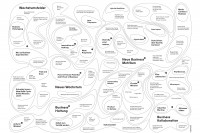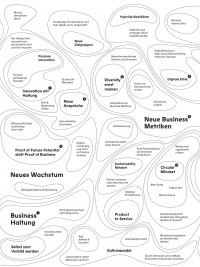New Year - New Growth


Discovering new things together: New Growth Map
The beginning of a new year is the best time to start thinking about where we want to go in the coming months. Just last year, we realigned ourselves and answered the call of New Growth. Because we remain convinced that doing business in the future must be based on a different set of value propositions: In the future, business enterprises must make a significant contribution to positive social change and to averting climate catastrophe. To this end, changes in the target systems must not be left out. These will no longer be based solely on the profit dimension, but will also have to include the parameters of people and planet. Realizing this ambition with simultaneous economic success is what we call New Growth.
To become more adaptable and resilient as a company, a transformation is needed in which economic, social and environmental factors are considered together. A transformation that pursues a value-driven realignment instead of preserving the status quo. Because the signs of the times are pointing to radical change. Change through new growth.
Thinking all this through is a complex undertaking. Which is why we set out to find a way to show the various connections, ambivalences, interrelationships, contradictions, parallels and dependencies. The result is the "New Growth Map". A map that makes it possible to experience New Growth in a visual-graphic way. A map that shows spaces of possibility for New Growth by placing exciting topics, trends and phenomena in context. It serves to explore the complex of topics intuitively and individually by oneself and to locate one's own topics and questions on it.
On the back of the card, there are also twelve terms that we will pick up again and again in our communication throughout the year. Here is an overview:
Business attitude
In order to master the challenges of the future in a commercially profitable way, companies need to think together about society, technology and business. It is particularly important to be able to deal with ambivalences and complexity. Between contradictions and opposites, such as long-term strategies versus quick wins, new success factors versus existing KPI frameworks, cross-industry innovation versus industry expertise, and radical visions versus agile working, they must be able to navigate and develop their own mindset.
Activist mindset
Activism must be lived not only on the street, but also in the company and in the economic system in general. This requires managers who have the courage to position their brand for socially relevant topics and to live this positioning in their daily work with employees and customers. The activist mindset required for this serves to make the value compass the basis for decision-making in the company - in this way it remains relevant and positions itself for the future.
Industries blurring & building alliances
Complex problems can no longer be solved or financed in isolation by individual actors or industries. Instead, allies, alliances and swarms are needed to create new access to resources and solutions. In this way, shared value can be created through common ecosystems and platforms - instead of just isolated products and services. A positive side effect is also that collaboration and exchange - modeled on the open innovation approach - between industries automatically increases the shared learning space. Open and collaborative ecosystems also have another advantage for companies: Unlike closed ecosystems, they do not impose limits on growth.
Breaking down silos
In order to implement new processes and innovations quickly and well, it is important to break down silos in companies: Interdisciplinary work and true collaboration are necessary for this. Companies that manage to do this find real solutions to problems and can offer products and services that stand out from the crowd.
New claims
Old claims do not solve new problems. In order to create significant innovations, a certain mindset is required. Ergo: If the way of doing business is to change, first of all one's own mindset and one's own demands have to change. Instead of settling for one-sided goals, it is important to resolve contradictions and serve them in parallel: short-term action with long-term visions, business impact with social responsibility, clear leadership with decentralized organizations.
Taking diversity seriously
Instead of letting diversity take place only in communication, companies need to show that they mean business and embed diversity in their organization, products & services and business models. Because in most cases, these are still geared to the wishes and needs of a privileged minority. Only when we start to address less exclusive problems and diverse target groups can companies make their contribution to social change. Our society is diverse and this must also be reflected in product development processes and departments.
Innovation with attitude
In companies, there is a lot of talk about social change, socially responsible transformation and sustainable strategies, but the corresponding results are a long time coming. Instead, in many places, products are still being created that the world does not need. True product and service innovation must ensure that people's everyday lives are not just more pleasant, but actually more livable.
New business metrics
We need new metrics for future business and innovation. This includes introducing contemporary metrics and aligning one's business accordingly. Instead of short-term gains, long-term ones should be pursued. To achieve this, it is necessary to make costs related to sustainability in the company and beyond transparent and to introduce a distinction between performance measurement for existing vs. new products. The growth ideal à la Hockey Stick has failed as an economic promise of the startup world.
Digital ethics
The moral claim of companies should not be to have success and growth at the expense of other people or the environment. Actors must therefore ask themselves what effects their own actions have and who ultimately bears the consequences. There is a need to actively deal with "unintended consequences" and to include and make transparent the long-term consequences. In addition, it is important to integrate or focus more strongly on the needs and expectations of marginalized target groups and stakeholders.
Circular Mindset
In times of resource scarcity, the responsible use of raw materials is more important than ever for every individual as well as for business and industry. A circular mindset helps companies to question existing practices and to rethink them in an innovative way. It is already becoming apparent that linear business models will soon be obsolete: The EU is discussing and adopting more and more rules on common standards for products - including the recycling of resources and the reparability of items. Circular concepts and business models not only protect people and nature. They also offer companies the opportunity to align their growth with values oriented toward the common good. These include ecological sustainability, social responsibility and value creation. In the future, these points will outweigh short-term profit thinking and lead to sustainable economic success.
Business Pretotyping & Business Experiments
Pretotype before Prototype: By quickly testing ideas at an early stage, a company can save a lot of money and, above all, make sense. Nothing is more annoying than tinkering with a product or service for a long time, which then does not fit the target group or the market. Pretotyping allows you to find out the weak points, but also the aspects of the innovation that work well, early enough to either confirm or reject your hypotheses. This requires the courage to experiment - and to fail.
Proof of Future Potential
When innovating in the area of business models, one often enters uncharted territory. At present, companies usually require a positive business case to legitimize an innovation project. However, when it comes to opening up new markets or establishing new services, this proof is difficult to provide and business plans tend to follow the logic of "fake it, till you make it" instead of common sense. After all, how can a new market that is to be created be expressed in figures in advance? New growth therefore requires proof that the market you are creating with your new business model has business potential in the future. So instead of a proof of business, you need a proof of future potential.
The map was created with the help of trend research methods, expert interviews and clustering. Contributors: Kristina Bonitz, Jennifer van der Heydt, Alexander Kiock, Silke Kreiling, Claudia Lang, Jan Pechmann, Mustafa Sahin, Daniel Schlee, Holger Schmitz, Alexander Werle.
Concept, text & graphics: Clara Iversen and Sophie Michel


